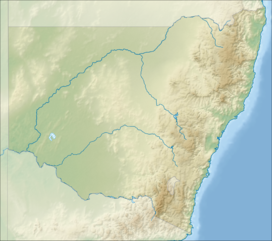Moonbi Range
| Moonbi | |
|---|---|

View of the Moonbi Range, from Flagstaff Mountain.
|
|
| Highest point | |
| Peak | Mount Black Jack |
| Elevation | 1,300 m (4,300 ft) AHD |
| Coordinates | 30°57′50″S 151°07′42″E / 30.96389°S 151.12833°E |
| Dimensions | |
| Length | 150 km (93 mi) NNW |
| Geography | |
|
Location of the Moonbi Range in New South Wales
|
|
| Country | Australia |
| State | New South Wales |
| Region | Northern Tablelands, New South Wales |
| Range coordinates | 31°12′S 151°25′E / 31.200°S 151.417°ECoordinates: 31°12′S 151°25′E / 31.200°S 151.417°E |
| Parent range | New England Range |
The Moonbi Range, a mountain range that is part of the Great Dividing Range, is located in the Northern Tablelands of New South Wales, Australia.
The range is located roughly 20 kilometres (12 mi) north east of the city of Tamworth situated at the bottom of the Wentworth Mounds, which is part of the Moonbi Range. These mounds form a spur of the Great Dividing Range where the North West Slopes meet to the Northern Tablelands. The Moonbi Range rises from 500–1,300 metres (1,600–4,300 ft) above sea level and it generally forms the divide between the watersheds of the Cockburn River to the south, and the Macdonald River to the north, which are both themselves tributaries of the Namoi River.
The higher parts of the area often receive a snowfall in the winter, and the highest peak in the range is called Black Jack Mountain at 1,300 metres (4,300 ft).
To the road traveller on the New England Highway, the Moonbi Range is notable as it is a major uphill climb on the highway as the motorist ascends from Moonbi at the foot of the 1st Moonbi Hill to the Northern Tablelands and the village of Bendemeer.
In 1832 Edward Gostwyck Cory blazed a track over the range that the existing highway has generally followed. A granite boulder named Cory’s Pillar (sometimes Cory’s Pillow or Cory’s Nightcap) commemorates where Cory is believed to have rested during his travels.
In his poem Over the Range, Andrew "Banjo" Paterson wrote of the obstacle that the Moonbi Range created for travelers to the Northern Tablelands. When Banjo Paterson was born in 1864, the Great North Road was still in poor condition making travel to the New England district for wagon teams very difficult. The mountain range was also immortalised in the annals of Australian country and western music by Buddy Williams. His song, The Mighty Moonbi Range, fitted into the truckdriving genre and included spellbinding verses such as, "Big Jim was a timber man with muscles made of steel. An iron nerve to hold the curve, two big hands on the wheel. But twenty tonnes of ironbark, the devils fatal load, went crashing off the Moonbi... the end of Big Jim's road."
...
Wikipedia

